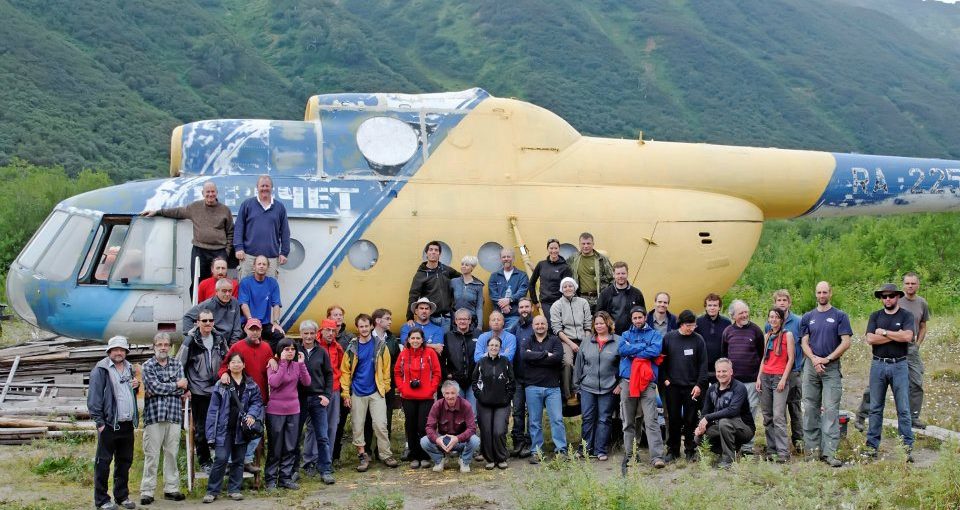Although today it seems hard to imagine volcanic gas measurements without thinking of routine SO2 gas flux measurements, remote sensing of volcanic gases has a history of less than half a century. Only in 1971 at Mt Mihara (Country?) the first Correlation Spectrometer (COSPEC) measurements were carried out to determine the volcanic SO2 output (Moffat et al., 1972), which has since become a very broadly applied technique, including for monitoring. The 1982 eruption of El Chichon (Mexico) was the first volcanic eruption during which SO2 was detected from space (Krueger 1983). Remote sensing combines several advantages – it allows (a) near continuous measurements, (b) real-time evaluations, (c) non – contact measurements, (d) direct identification of trace gas molecules and overall (e) enables measurements to be collected at a safe distance from the volcano, even during explosive eruptions. Remote sensing of volcanic gases can be carried out from different platforms, from the ground up to space, the latter which provides the opportunity to detect volcanic degassing at volcanoes around the planet on a daily basis.
A variety of remote sensing techniques for measuring volcanic plumes have been developed during the last few decades. These techniques can be grouped into dispersive (e.g. DOAS) and non-dispersive (e.g. SO2 Camera) approaches and into active (using their own artificial radiation source e.g. LIDAR) and passive (using natural sources of radiation e.g. sunlight or the thermal emission of the gas to be measured) techniques (Platt et al., 2015). Remote sensing measurements rely on the analysis of radiation emitted, absorbed, or scattered by gases and aerosols in volcanic plumes. Dispersive techniques determine a complete wavelength-dependent intensity spectrum for each pixel. The trace gas column density (TGCD) for that particular pixel is then derived from the measured spectrum and calibration spectra. Non-dispersive approaches derive the TGCD from a small number (typically one) integrated intensity measurement at suitable wavelengths. Frequently, a reference intensity at one (or very few) different wavelength(s) is recorded and the TGCD is derived from the ratio of the two intensities (or as a function of a few intensity measurements).
Dispersive methods are usually more complex and slower than non-dispersive techniques. Their advantage lies in the fact that data collected with higher spectral resolution allow a much better identification of a particular trace gas and a more accurate removal of interferences from other gas species. Furthermore, analyses done using traceable, well-quantified absorption cross-sections increases the rigour of the technique. Many gas absorption features are naturally narrow, particularly for small molecules, and this limits the effectiveness of non-dispersive techniques. In fact, non-dispersive techniques have been only applied to major components (like SO2) of volcanic plumes, while trace species (like BrO) have been detected by dispersive approaches (Platt et al., 2015).
In addition to quantifying SO2 emissions, remote sensing has also been used since the nineteenth century to detect and quantify other volcanic gases including: HCl, H2O, SO2, HF, CO2, SiF4, OCS and CO through the development of the first field portable Fourier Transform Infrared (FTIR) spectrometer instruments (e.g. Notsu et al., 1993, Mori et al., 1993, Mori et al., 1997). In fact, an important aim of present research is to develop techniques to detect a broader range of molecules and to image in two and three dimensions the distribution of volcanic gases within plumes. Despite impressive accomplishments, many techniques are still in an early stage of development and much progress can be expected in the near future.
The main disadvantages of remote sensing techniques for quantifying volcanic gas emissions are (1) the limited number of species determined, (2) the complex analysis for most species, and (3) the difficulty to differentiate isotopes. In particular, two volcanic activity-driving gases, CO2 and H2O, are hard to measure due to their high abundance in ambient air and in the case of water its high variability over time and space. However, some successful remote sensing measurements for CO2 have been carried out (e.g. Goff et al., 2001).
A further challenge for measuring volcanic gases down-wind from the emission source is the possible chemical conversion of reactive gas species that can only be corrected when the complex mixing and reactions between volcanic gases and the surrounding atmosphere are well constrained.
In addition to modern technical advances in the hardware offering robust, relatively small and cheap spectrometers, much has been done to improve data analysis software, and work is currently underway to improve imaging processing. The latter, which will help improve our understanding of the heterogeneity inside volcanic plumes, the plume–atmospheric mixing and chemical transformation processes. Also long known problems, like radiative transfer in volcanic plumes and the atmosphere, remain to be solved, for example through improved radiative transfer modelling for the accurate determination of gas fluxes.
References:
Goff, F., Love, S. P., Warren, R. G., Counce, D., Obenholzner, J., Siebe, C., & Schmidt, S. C. (2001). Passive infrared remote sensing evidence for large, intermittent CO 2 emissions at Popocatépetl volcano, Mexico. Chemical Geology, 177(1), 133-156.
Krueger, A. J. (1983). Sighting of El Chichon sulfur dioxide clouds with the Nimbus 7 total ozone mapping spectrometer. Science, 220(4604), 1377-1379.
Moffat, A. J., Kakara, T., Akimoto, T. and Langan, L. (1972) Air Note. Environmental Measurements, San Francisco.
Platt U, Lübcke P, Kuhn J, Bobrowski N, Prata F, Burton M, Kern C (2015) Quantitative imaging of volcanic plumes — Results, needs, and future trends. J Volcanol Geotherm Res 300:7–21. doi: 10.1016/j.jvolgeores.2014.10.006

